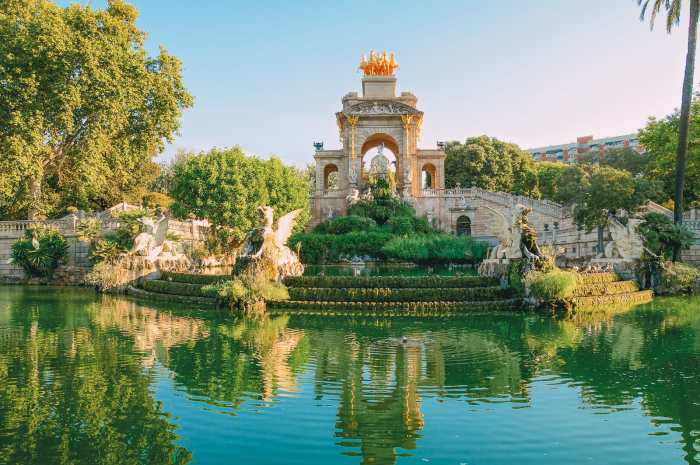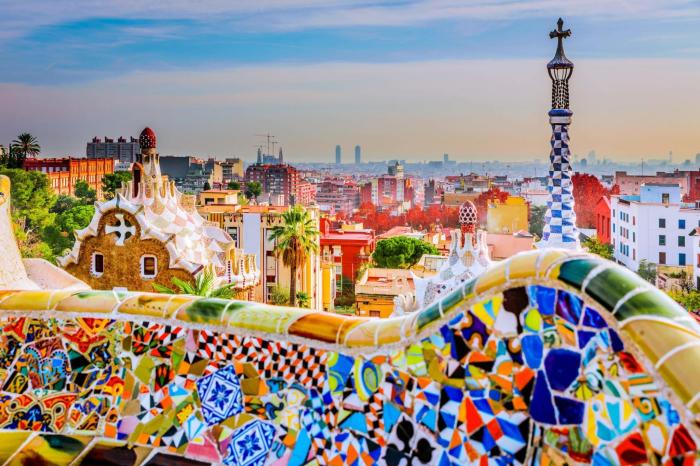
Free things to do in Barcelona: Discover a city brimming with vibrant culture, stunning architecture, and breathtaking coastal views – all without breaking the bank. From exploring picturesque parks and historical landmarks to strolling along sun-kissed beaches and immersing yourself in the city’s artistic heart, Barcelona offers a wealth of free experiences. This guide unveils a curated selection of activities, ensuring an unforgettable and budget-friendly adventure in this captivating Catalan capital.
Whether you’re a history buff, a nature lover, an art enthusiast, or simply seeking a relaxing getaway, Barcelona caters to every taste. We’ll guide you through meticulously planned walking routes, showcasing iconic architectural marvels and hidden gems. You’ll discover tranquil parks perfect for picnics and relaxation, and vibrant beaches ideal for sunbathing and people-watching. We’ll even reveal the secrets to experiencing Barcelona’s rich cultural offerings without spending a fortune, including free admission days at renowned museums and galleries.
Free Activities in Barcelona
Barcelona, a city brimming with architectural wonders and vibrant culture, also offers a wealth of free activities for visitors seeking a more budget-friendly experience. Exploring its expansive parks and green spaces is a fantastic way to immerse yourself in the city’s beauty without spending a dime. These tranquil oases provide respite from the bustling city life and offer a unique perspective on Barcelona’s diverse landscape.
Barcelona Parks & Green Spaces: Free Access and Unique Features
Barcelona boasts numerous parks, each with its own distinct character and charm. Five notable examples offer free access to all visitors, providing opportunities for relaxation, recreation, and exploration. Below is a comparison of their size, accessibility, and key attractions.
| Park Name | Approximate Size | Accessibility | Notable Attractions |
|---|---|---|---|
| Parc de la Ciutadella | 17 hectares | Excellent; paved paths, ramps | Lake, cascade, zoo, monuments |
| Parc Güell (Free Access to certain areas) | 17.18 hectares | Good; some hilly areas, paved paths | Gaudí’s architecture, panoramic views |
| Jardins de Laribal | 4.5 hectares | Good; mostly flat, paved paths | Romantic atmosphere, fountains, hidden corners |
| Parc de Montjuïc | 129 hectares | Moderate; hilly terrain, some uneven paths | Montjuïc Castle, museums, gardens |
| Horta Labyrinth Park | 9.1 hectares | Good; mostly flat, some gravel paths | Historical garden, classic maze, neoclassical architecture |
Half-Day Itineraries for Different Visitor Types
Planning a half-day visit to a Barcelona park can be a delightful experience tailored to individual preferences.
Below are suggested itineraries for families, couples, and solo travelers.
Family Itinerary (Parc de la Ciutadella): Begin at the main entrance, rent a rowboat on the lake for a relaxing experience, visit the small zoo, let the children run and play in the expansive green spaces, and finish with a picnic lunch under the shade of a tree near the monumental fountain.
Couple’s Itinerary (Jardins de Laribal): Start with a leisurely stroll through the hidden pathways, discover the romantic fountains and hidden nooks, enjoy a quiet moment by one of the less crowded benches, and end the afternoon with a shared ice cream while enjoying the peaceful ambiance.
Solo Traveler Itinerary (Parc Güell – Free Access Areas): Explore the free sections of Parc Güell, focusing on the stunning mosaic benches and the unique architecture of Gaudí’s design. Find a quiet spot to sit and sketch the scenery, or simply enjoy the panoramic views of the city while contemplating the artistic genius of Gaudí.
Picturesque Spots in Barcelona Parks: A Sensory Exploration
Each park possesses a unique picturesque spot that engages all the senses.
Parc de la Ciutadella: The monumental fountain, a cascading spectacle of water and sculpted figures, offers a visual feast. The sound of rushing water blends with the chatter of visitors and the songs of birds. The air carries a hint of damp earth and the scent of blooming flowers.
Parc Güell (Free Access Areas): The mosaic benches, vibrant with colorful tiles, create a striking visual display. The gentle sounds of wind chimes mingle with the distant hum of the city. The air is filled with the fragrance of Mediterranean herbs and flowers.
Jardins de Laribal: A secluded fountain hidden amongst lush greenery provides a tranquil scene. The gentle murmur of water creates a peaceful atmosphere, punctuated by the chirping of birds. The air is redolent with the fragrance of roses and other blooming plants.
Parc de Montjuïc: The panoramic view from Montjuïc Castle offers a breathtaking vista of the city skyline and the Mediterranean Sea. The sounds of seagulls cry out against the gentle breeze, while the air is infused with the salty tang of the sea and the earthy scent of the surrounding hills.
Horta Labyrinth Park: The neoclassical architecture and the intricate design of the maze create a visually stunning experience. The rustling of leaves and the gentle chirping of birds provide a calming soundscape. The scent of ancient trees and blooming flowers fills the air.
Free Walking Tours & Historical Sites

Barcelona offers a wealth of historical sites perfect for exploring on foot, and many are completely free to visit. A self-guided walking tour allows you to delve into the city’s rich past at your own pace, discovering hidden gems and iconic landmarks along the way. This itinerary focuses on three key locations, offering a glimpse into Barcelona’s evolution through the ages.
A Suggested Walking Route: Gothic Quarter Exploration
This route begins at the Barcelona Cathedral, proceeds to Plaça Sant Jaume, and concludes at the Palau de la Generalitat. The walk is approximately 1.5 kilometers and takes around 45-60 minutes, excluding time spent exploring each site. Allow extra time for enjoying the atmosphere and perhaps a coffee break at one of the many charming cafes along the way.
Barcelona Cathedral: A Gothic Masterpiece
The Barcelona Cathedral, officially known as the Cathedral of the Holy Cross and Saint Eulalia, stands as a testament to Catalan Gothic architecture. Construction began in the 13th century, with significant additions and modifications spanning several centuries. Its architectural significance lies in its intricate facade, soaring spires, and the cloister, which houses a tranquil garden and a collection of orange trees.
The cathedral’s history is deeply intertwined with the city’s religious and political life, serving as a focal point for centuries. Its location in the heart of the Gothic Quarter reflects its enduring importance to Barcelona’s identity.
Plaça Sant Jaume: The Heart of Catalan Government
Plaça Sant Jaume, situated in the very center of the Gothic Quarter, is a vibrant square housing two significant buildings: Barcelona City Hall (Ajuntament de Barcelona) and the Palau de la Generalitat, the seat of the Catalan Government. This square has witnessed centuries of political and social events, serving as a stage for royal proclamations, public executions, and significant civic celebrations.
The architectural styles of both buildings reflect different periods in Barcelona’s history, showcasing a blend of Gothic and Baroque influences. The square itself is a beautiful space, often bustling with activity, providing a sense of the city’s pulse.
Palau de la Generalitat: Seat of Catalan Power, Free things to do in Barcelona
The Palau de la Generalitat, the official residence of the President of the Generalitat of Catalonia, is a magnificent example of Catalan Gothic architecture. Its construction began in the 14th century and has undergone various renovations throughout its history. The building’s architectural details, including its intricate carvings, decorative elements, and the courtyard, showcase the artistry of the period. The Palau has been a crucial center of Catalan political power, playing a vital role in shaping the region’s history and identity.
The building’s history reflects the complex relationship between Catalonia and Spain, symbolizing both Catalan autonomy and the struggles for self-governance.
Map of the Walking Route
Imagine a map showing three points connected by lines representing streets.Point 1: Barcelona Cathedral (located near the top-left of the imagined map). A small icon representing a cathedral could be placed here. Nearby cafes are abundant in this area.Point 2: Plaça Sant Jaume (located in the center of the imagined map). An icon representing a city square could be placed here.
Numerous cafes surround this central square, offering various options for a coffee break.Point 3: Palau de la Generalitat (located near the bottom-right of the imagined map). An icon representing a government building could be placed here. Several cafes and restaurants are within a short walking distance of this location.The lines connecting the points would represent the walking route, showing the general direction of travel.
The map could also include small icons representing other points of interest along the way, such as smaller churches, historical buildings, or noteworthy streets. It would not be a detailed street map but rather a schematic representation of the route.
Free Beaches & Coastal Experiences: Free Things To Do In Barcelona
Barcelona boasts a stunning coastline, offering visitors a variety of free beach experiences. From the lively atmosphere of Barceloneta to the quieter stretches further afield, there’s a beach to suit every taste. Exploring these coastal gems is a fantastic way to enjoy the city without breaking the bank.
Barcelona Beach Comparison
The following table compares three popular Barcelona beaches, highlighting their accessibility, atmosphere, and nearby amenities. Choosing the right beach depends on your preferences and what you’re looking for in a beach day.
| Beach Name | Accessibility | Atmosphere | Nearby Amenities |
|---|---|---|---|
| Barceloneta | Excellent; easily accessible by public transport and on foot. | Lively and bustling; full of activity, restaurants, and bars. | Numerous restaurants, bars, shops, and water sports rentals. |
| Bogatell | Good; accessible by public transport and a pleasant walk or cycle from the city center. | More relaxed than Barceloneta; less crowded and family-friendly. | Fewer amenities than Barceloneta, but still some restaurants and bars nearby. |
| Nova Icària | Good; accessible by public transport and a pleasant walk or cycle from the city center. | Calm and peaceful; ideal for those seeking a quieter beach experience. | Fewer amenities than Barceloneta and Bogatell, but a more tranquil setting. |
A Day at Barceloneta Beach
Spending a day at Barceloneta Beach is an immersive experience. The sights are a constant flurry of activity: sunbathers spread across the golden sand, volleyball games in progress, and the rhythmic crash of waves against the shore. The sounds are equally vibrant – the cheerful chatter of beachgoers, the squeals of children playing, the rhythmic thump of beach music from nearby chiringuitos (beach bars), and the ever-present sound of the sea.
Activities abound: swimming in the Mediterranean, trying out stand-up paddleboarding, building elaborate sandcastles, or simply relaxing and soaking up the sun. The constant flow of people creates a vibrant, energetic atmosphere. The smell of salt and sunscreen mixes with the tantalizing aromas drifting from the many nearby restaurants.
Barceloneta Sunset
A Barceloneta sunset is a breathtaking spectacle. The color palette shifts dramatically as the sun dips below the horizon. First, vibrant oranges and yellows dominate, painting the sky in fiery hues. As the sun descends further, these bright colors mellow into softer pinks and purples, creating a serene and peaceful atmosphere. The Mediterranean Sea reflects these changing colors, its surface shimmering with a thousand tiny lights.
The overall mood is one of tranquility and awe, a perfect ending to a day spent enjoying the beach. The silhouette of the city skyline against the fading light adds a touch of urban charm to the natural beauty of the scene. The air is filled with a sense of calm and contentment, as the day gives way to the cool evening air.
Free Cultural Experiences

Barcelona offers a wealth of cultural experiences beyond the typical tourist trail, many of which are entirely free. Taking advantage of free admission days at museums and galleries allows you to delve into the city’s artistic heritage without breaking the bank. This section highlights some options and suggests a possible itinerary for maximizing your time.
Museums and Galleries with Free Admission Days
Several museums and galleries in Barcelona offer free admission on specific days or at specific times. Checking their official websites for the most up-to-date information is always recommended, as schedules can change. The following are examples, but always verify the details before your visit.
The information below is based on generally available information and may be subject to change. Always check the official museum website for the most current details on free admission days and times.
1. Museu Picasso: While not entirely free, the Museu Picasso often offers free admission evenings or on certain holidays. Their collection boasts a comprehensive overview of Picasso’s early years, showcasing his formative works and development as an artist. Key pieces include his “First Communion” and a series of works depicting Barcelona’s street life. Check their official website for specific free admission dates and times.
2. Museu d’Art Contemporani de Barcelona (MACBA): MACBA occasionally provides free entry on specific days or evenings, particularly during special events or exhibitions. This museum features a wide array of contemporary art, including paintings, sculptures, installations, and video art, reflecting diverse artistic movements and styles from the late 20th and early 21st centuries. Noteworthy collections include works by Antoni Tàpies and Joan Miró.
Consult their website for updated free admission information.
3. Centre de Cultura Contemporània de Barcelona (CCCB): The CCCB frequently hosts free exhibitions and events, often focusing on social and political themes through a multidisciplinary lens. Their exhibitions are usually temporary, so checking their calendar for current offerings and free admission days is essential. The CCCB’s focus is on contemporary culture, encompassing art, film, literature, and other mediums.
Their website will list free events and exhibitions.
Sample Itinerary: MACBA and Museu Picasso
This itinerary suggests a half-day exploring two museums, assuming free admission is available on the chosen day.
Morning (10:00 AM – 1:00 PM): Begin at MACBA. Allow approximately 2-3 hours to explore the collection thoroughly. The museum’s architecture itself is a work of art, so take time to appreciate the building. Afterward, enjoy a light lunch at a nearby cafe.
Afternoon (2:00 PM – 5:00 PM): Walk from MACBA to the Museu Picasso (approximately a 20-30 minute walk, or a short metro ride). Spend the afternoon immersed in Picasso’s early works. The museum is relatively compact, allowing for a comprehensive visit within a few hours.
This itinerary is a suggestion; adjust the timings based on your interests and the specific exhibitions on display. Remember to check the opening hours of both museums before your visit.
Exploring Barcelona’s Architecture
Barcelona boasts a captivating architectural landscape, a fascinating blend of styles reflecting its rich history and cultural influences. A self-guided walking tour allows you to appreciate the city’s architectural gems at your own pace, discovering the stories embedded within the stones. This exploration will focus on key buildings showcasing the evolution of Barcelona’s architectural identity.Barcelona’s architectural character is a product of various historical periods and artistic movements.
From the Gothic Quarter’s medieval structures to the modernist masterpieces of Antoni Gaudí and the more contemporary designs of the 21st century, the city presents a compelling narrative of architectural evolution. Understanding these influences allows for a deeper appreciation of the buildings themselves and their placement within the broader urban context.
Notable Buildings and Architectural Styles
The following buildings represent a diverse range of architectural styles that have shaped Barcelona’s skyline. Each offers a unique insight into the city’s architectural heritage.
- Barcelona Cathedral (Santa Eulàlia): Gothic. This cathedral exemplifies the late Gothic style prevalent in the 13th and 14th centuries. Its imposing facade features intricate carvings and pointed arches, characteristic of the period. The most striking detail is the soaring central nave, creating a sense of awe and reverence.
- Casa Batlló: Modernisme (Catalan Modernism). Designed by Antoni Gaudí, Casa Batlló is a prime example of Modernisme, characterized by its organic forms and vibrant colors. Its undulating facade, resembling a dragon’s spine, is its most striking feature, showcasing Gaudí’s imaginative use of materials and his mastery of sculptural architecture. The building’s roofline, reminiscent of a fantastical creature’s back, is especially captivating.
- Casa Milà (La Pedrera): Modernisme (Catalan Modernism). Another masterpiece by Gaudí, La Pedrera is known for its wave-like facade and its unique rooftop with its whimsical chimneys. The undulating facade, sculpted from stone, is remarkably fluid and organic, reflecting Gaudí’s inspiration from nature. The whimsical chimneys, sculpted into fantastical forms, are the most striking detail of the rooftop.
- Palau de la Música Catalana: Modernisme (Catalan Modernism). This concert hall, designed by Lluís Domènech i Montaner, is a stunning example of Catalan Modernism. Its interior is particularly breathtaking, showcasing elaborate stained glass, wrought iron, and mosaics. The abundance of natural light filtering through the stained glass dome is the most visually striking element, creating a magical atmosphere within the concert hall.
- Sagrada Família: Modernisme (Catalan Modernism). Gaudí’s unfinished masterpiece, the Sagrada Família, is a symbol of Barcelona. Its towering spires, intricate facades, and complex geometry exemplify Gaudí’s unique style. The intricate carvings depicting biblical scenes and the sheer scale of the basilica are the most striking details, creating a sense of wonder and awe.
Exploring Barcelona on a budget doesn’t mean sacrificing an enriching and memorable experience. This guide has unveiled a diverse range of free activities, allowing you to fully immerse yourself in the city’s unique charm without financial constraints. From the serene beauty of its parks to the historical significance of its landmarks and the artistic vibrancy of its museums, Barcelona offers an abundance of free delights.
So, pack your bags, embrace the spirit of adventure, and embark on a cost-effective journey through this captivating city. Enjoy the many free treasures Barcelona has to offer!
FAQ Explained
What is the best time of year to visit Barcelona for free activities?
Shoulder seasons (spring and autumn) offer pleasant weather and fewer crowds, making it ideal for enjoying free outdoor activities.
Are there any free Wi-Fi hotspots in Barcelona?
Many cafes, restaurants, and public spaces offer free Wi-Fi. Check for availability when needed.
How safe is it to walk around Barcelona at night?
While generally safe, it’s advisable to stick to well-lit and populated areas, especially at night.
What language is spoken in Barcelona?
Catalan and Spanish are the official languages, but English is widely spoken in tourist areas.




